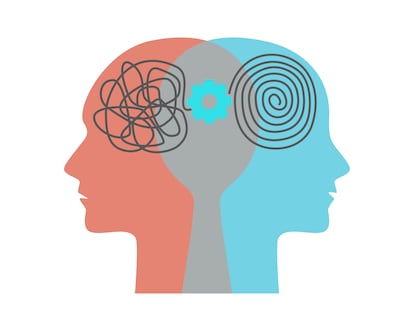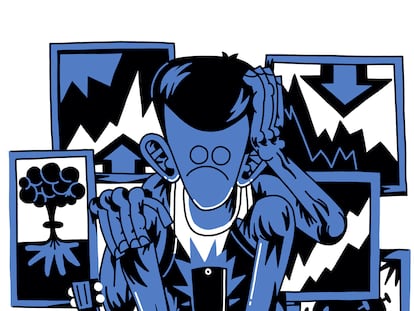What is and what is not a bipolar disorder, the most trivialized serious mental problem
Don’t confuse it with normal mood swings, intense emotional reactions, or unstable personalities

Bipolar disorder is probably the most trivialized serious mental disorder. In contrast to the terms schizophrenia or anorexia nervosa, which bring to mind something sordid and dark, the so-called “bipolarity” hints at a playful alternation between the expansive and the sad, between the friendly and the angry. “My boss must be bipolar” or “I’m a little bipolar” – followed by a knowing chuckle – are already classics of contemporary trivial conversations. This misunderstanding is particularly unfair to the patients and families who do suffer from this serious disorder, the seventh leading cause of disability worldwide.
Nowadays, given the proliferation and extension of diagnostic labels to the variants of normality, we must be attentive precisely to what are not mental disorders. Diagnostic classification systems (ICD-11 or DSM-5) were necessary and useful in the history of psychiatry to finally use a common language that was more or less reliable in what was akin to a Tower of Babel. But their cursory descriptions of the disorders, with lists of criteria checked off by a diagnostician based on clinical observation or symptom reporting, easily mean that anyone, on a bad day, can be diagnosed with several things at once. There is no depth in the psychopathological exploration or a sense of measure when setting the threshold of the dysfunctional. In this way, prevalence grows, comorbidities – the coexistence of several disorders – increase, and this over diagnosis ends up harming those who actually have a serious and limiting disorder, who become part of a web of banalities and receive poor care. For example, it is reasonable to think that having intense negative emotions such as sadness, anger, disappointment, bitterness, and desolation, in certain circumstances, does not necessarily mean one has a disorder. Imagine the absurdity of reducing the opulent emotional catalog of the gods of the Greek pantheon or the characters of the 19th-century Russian novel to a few diagnostic categories.
Humans are always emotional, their brain constantly evaluating their internal and external environment in order to trigger preprogrammed responses (yeah, free will is overrated). Emotions are patterns of neurovegetative, hormonal and behavioral adaptation typical of our species, which can be intense and can be accompanied by feelings, that is, from private and subjective experience, with a more elaborate cognitive component. Depending on the social or family context, negative emotions and feelings may be the most adaptive ways of surviving. Demanding a standard or correct ― or even happy ― mood from people with miserable lives is simply foolish. The psychiatrist is often asked to raise that mood without touching the environment, a magic trick that antidepressants (very useful when used correctly) fail to perform. We humans get excited, we feel and, sometimes, very intensely, we are passionate. Romanticism has led us to limit the idea of passion ― that “vehement feeling, able of dominating the will and disturbing reason” ― to the love for a partner or a nation, but Gregorio Marañón has told us, for example, of the passion of commanding (in the impressive biography of the Count-Duke of Olivares) or of resentment (in the biography of Tiberius). At the consultation, and in our environment, we meet people who are moved by the irresistible passion of envy, resentment, the desire to excel, hatred, joy, love without limits that can turn into emptiness, the insurmountable struggle to alter the law of gravity or the pure desire to be someone else (examples abound). Go to a mental health consultation and you will witness an immense catalog of human nature that would not have been considered pathological in a different era, a liquid, 2.0 version of The Iliad, along with a helpless representation of people with serious mental disorders that, if the overwhelming waiting list allows, barely receive the help they need. Thus, the intensity and the depth of normal human emotions are not a bipolar disorder.
Additionally, bipolar disorder can be confused with an emotional instability caused by certain character traits. Remember that personality is a deep-rooted pattern of psychological characteristics that we theoretically retain over time and that make us different from others and similar to ourselves throughout life. This is quite theoretical, because we have all had the occasional feeling of entering a horror chamber of memories and seeing ourselves as total strangers. The award-winning Spanish novelist Javier Marías tells it more elegantly in his glorious All Souls: “The person recounting here and now what he saw and what happened to him is not the same person who saw those things and to whom those things happened; neither is he a prolongation of that person, his shadow, his heir or his usurper.” However, having said that, in general terms, we can consider that we all have a more or less defined personality, made up of temperament (what is innate, genetic, the cards that we are dealt) and character (what results from the interaction with the environment, what is forged through experience, the card game itself). There are personality traits, of multifactorial cause, such as the permanent desire to please others or to be the center of attention, to control the environment (including our loved ones), the need to be endlessly admired and flattered, a real or imagined fear of abandonment, and more, which easily lead to emotional instability, to sudden mood changes. A person starts the day quite happy, but finds out that they are not invited to the company dinner (the email went to the spam folder) and suddenly their heart goes to their feet and they think that they are being ghosted and that no one appreciates and loves them enough, and they become filled with rage and contempt. Indeed: your boss is not bipolar, she is probably narcissistic or controlling.
Bipolar disorder is something else. It affects around 1.5% of the population and is the alternation of phases of depression (an actual depressive illness, not “slumps” or frustrations) with manic episodes in which the subject is abnormally expansive or irritable, with verbosity, accelerated thinking, megalomaniacal ideas of omnipotence, a reduction in sleep hours (not insomnia: the patient does not need to sleep), impulsiveness, risky behavior, exorbitant expenses and, in almost half of the cases, delusions and hallucinations (they may believe that they have powers or hear voices). It is a serious thing: the patient does not think they have any problem at all – it is common for them to refuse admission or medication – and it’s hard to predict how the case will end, but it could be badly. Fortunately, there are useful drugs to “reduce” these conditions and others – the blessed lithium salts, to which at least a third of patients fully respond – that prevent relapses. We have more trouble treating bipolar depression, as there are fewer and less effective tools, and much of the disability of the disorder is associated with it. At Barcelona’s Hospital Clìnic they have one of the world’s leading groups for bipolar disorder, and one of their contributions has been to provide evidence of the efficacy of psychoeducation for this disease. Giving the patient tools to learn about the disorder, to deal with it, to minimize its impact on each one’s personal project, to adhere to treatments that work... this has turned out to be essential for a good evolution. More proof that a pharmacological approach to severe mental disorders must always be accompanied by psychotherapy, because it is effective and because it gives meaning and significance to the treatment.
Bipolar disorder is a serious condition and we must offer all effective resources for the affected population, in a universally accessible way. This requires providing means, personnel and knowledge, and fighting the trivialization of the term.
Tu suscripción se está usando en otro dispositivo
¿Quieres añadir otro usuario a tu suscripción?
Si continúas leyendo en este dispositivo, no se podrá leer en el otro.
FlechaTu suscripción se está usando en otro dispositivo y solo puedes acceder a EL PAÍS desde un dispositivo a la vez.
Si quieres compartir tu cuenta, cambia tu suscripción a la modalidad Premium, así podrás añadir otro usuario. Cada uno accederá con su propia cuenta de email, lo que os permitirá personalizar vuestra experiencia en EL PAÍS.
¿Tienes una suscripción de empresa? Accede aquí para contratar más cuentas.
En el caso de no saber quién está usando tu cuenta, te recomendamos cambiar tu contraseña aquí.
Si decides continuar compartiendo tu cuenta, este mensaje se mostrará en tu dispositivo y en el de la otra persona que está usando tu cuenta de forma indefinida, afectando a tu experiencia de lectura. Puedes consultar aquí los términos y condiciones de la suscripción digital.
More information
Últimas noticias
EU’s prestige at stake with proposal to fund Ukrainian war effort with Russian assets
Mustafa Suleyman: ‘Controlling AI is the challenge of our time’
Venezuela breaks energy agreements with Trinidad and Tobago due to alleged complicity with the US
The murder of Michele and Rob Reiner: A tale of horrific days in Hollywood
Most viewed
- ‘El Limones’ and the growing union disguise of Mexican organized crime
- Christian Louboutin: ‘Young people don’t want to be like their parents. And if their parents wear sneakers, they’re going to look for something else’
- ‘We are dying’: Cuba sinks into a health crisis amid medicine shortages and misdiagnosis
- A mountaineer, accused of manslaughter for the death of his partner during a climb: He silenced his phone and refused a helicopter rescue
- The low-cost creative revolution: How technology is making art accessible to everyone











































